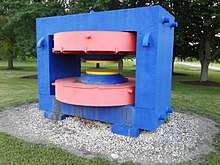William Draper Harkins
William Draper Harkins (December 28, 1873 – March 7, 1951) was an American chemist, notably for his contributions to nuclear chemistry. Harkins researched the structure of the atomic nucleus and was the first to propose the principle of nuclear fusion,[1][2] four years before Jean Baptiste Perrin published his theory in 1919-20. His findings enabled, among other things, the development of the H-bomb.
William Draper Harkins | |
|---|---|
| Born | December 28, 1873 |
| Died | March 7, 1951 (aged 77) |
| Nationality | U.S. |
| Alma mater | Stanford University |
| Awards | Willard Gibbs Award (1928) |
| Scientific career | |
| Fields | nuclear chemistry |
| Institutions | University of Montana University of Chicago |
| Doctoral students | Lyle Benjamin Borst |
Harkins was born in Titusville, Pennsylvania.
Harkins graduated with a PhD from Stanford University in 1907,[3] and subsequently taught chemistry at the University of Montana from 1900 to 1912. He spent the rest of his career at the University of Chicago.
Harkins correctly predicted the existence of the neutron in 1920 (as a proton–electron complex) and was the first to use the word "neutron" in connection with the atomic nucleus.[4][5] The neutron was detected experimentally by James Chadwick in 1932.
In the beginning of the 1930s, Harkins built a cyclotron. From experiments with this, he concluded that the sun might be powered by nuclear fusion. Among other University of Chicago scientists who made use of this cyclotron was Enrico Fermi, who performed neutron diffusion experiments.[6]
Since 1978, the magnet yoke of the cyclotron Harkins built has been on display at Fermilab.

Among his students were Lyle Benjamin Borst, Calvin Souther Fuller, Martin Kamen, Samuel Allison, and Robert James Moon, Jr. (1911–1989).
Harkins died in Chicago. He is buried at Oak Woods Cemetery.
References
- Michael, R. Blake (1992). The Origins of Vīraśaiva Sects: A Typological Analysis of Ritual and Associational Patterns in the Śūnyasaṃpādane. Motilal Banarsidass Publishing. p. 173. ISBN 9788120806986. OCLC 490456056.
- Robert S. Mulliken (1975). "William Draper Harkins 1873 - 1951" (PDF). Biographical Memoirs. National Academy of Sciences. 47: 48–81.
- Draper Harkins, William (1907). Excess-Potential and the Marsh Test (PhD thesis). Stanford University.
- Harkins, William (1921). "The constitution and stability of atomic nuclei. (A contribution to the subject of inorganic evolution.)". Philos. Mag. 42 (249): 305. doi:10.1080/14786442108633770.
- Linus Pauling, General Chemistry, second edition, 1970, p. 102
- "New Outdoor Display" (PDF). Ferminews: Fermi National Accelerator Laboratory. 8 June 1978. p. 4. Retrieved 8 June 2017.